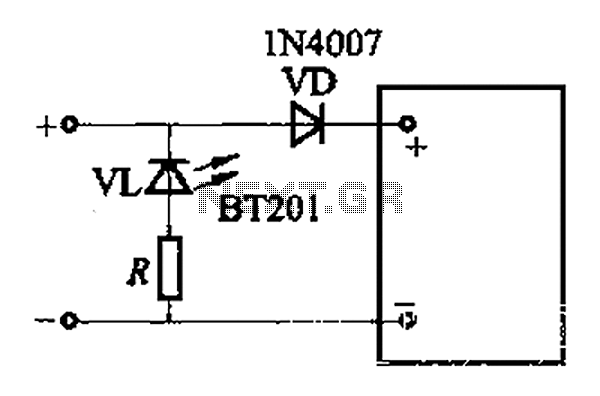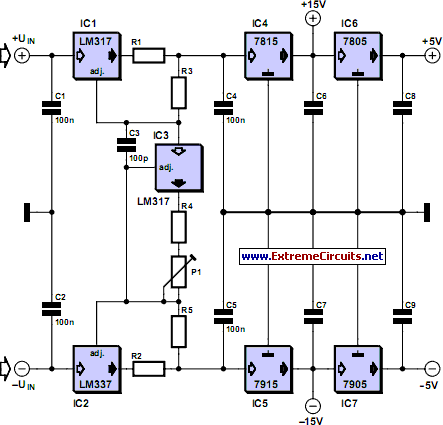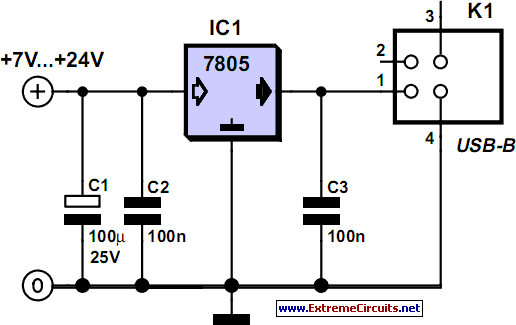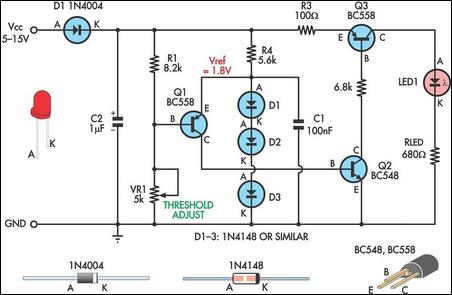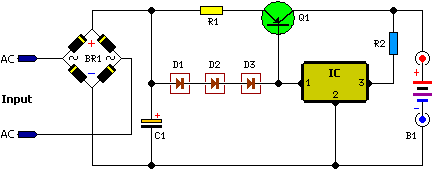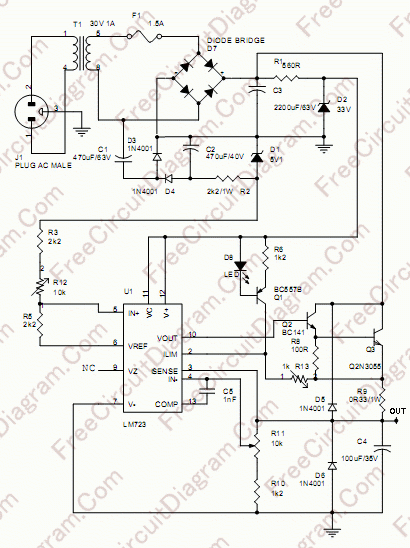
10 Amp 13 8 Volt Power Supply

The circuit includes a current limiting feature that is more reliable than most commercial units. It employs three pass transistors that require heat sinks. Resistor R9 allows for fine-tuning of the output voltage to precisely 13.8 volts, while the resistor network formed by resistors R4 through R7 manages the current limiting. The LM723 monitors the current when the voltage drop across R5 approaches 0.7 volts. To reduce costs, many commercial units depend on the HFE of the pass transistors for current limiting, which poses a risk of thermal runaway due to the increase in HFE as the transistors heat up. This circuit mitigates thermal runaway by sampling the collector current of the pass transistors, thus providing a more reliable power supply. The only adjustment needed is setting R9 to achieve an output voltage between 10 and 14 volts, which can be facilitated with a front panel-mounted 1K potentiometer if desired. Resistor R1 enhances temperature stability but can be omitted by connecting pins 5 and 6 of IC-1. Although not necessary due to the current limiting method employed, overvoltage protection can be integrated by connecting the circuit shown in Figure 2 to Vout. Overvoltage conditions could arise only if transistors Q2 or Q3 fail with a collector-to-emitter short, although it is more likely that transistors will open when they fail.
The circuit is designed to provide a stable and adjustable power supply, characterized by its robust current limiting feature that ensures reliability. The use of three pass transistors necessitates adequate heat sinking to prevent overheating during operation, which is critical for maintaining performance and longevity. Resistor R9 is pivotal in fine-tuning the output voltage; it allows for precise adjustments to achieve the desired voltage level, which can range from 10 to 14 volts. The implementation of a 1K potentiometer for this adjustment enhances user convenience, enabling dynamic voltage changes as required.
The current limiting aspect is managed through a network of resistors (R4 to R7) that effectively regulate the output current. This configuration stands out against conventional designs that often rely on the HFE parameter of transistors. The inherent flaw in such designs is the propensity for thermal runaway, a condition where increased temperature leads to higher HFE, potentially resulting in transistor failure. In contrast, this circuit samples the collector current, allowing for a proactive response to changes in load conditions, thereby minimizing the risk of thermal runaway.
The design also incorporates an optional overvoltage protection mechanism. Although this feature is not essential due to the inherent current limiting design, it provides an additional layer of safety. By connecting an external circuit to Vout, the risk of overvoltage conditions can be mitigated, particularly in scenarios where transistors Q2 or Q3 might fail. The likelihood of a collector-to-emitter short is low, but the design accommodates this possibility, ensuring that the power supply remains robust under various operating conditions.
Overall, this circuit exemplifies a well-thought-out approach to power supply design, prioritizing reliability, user adjustability, and safety.The circuit even has a current limiting feature which is a more reliable system than most commercial units have. The circuit uses 3 pass transistors which must be heat sink. Resistor R9 allows the fine tuning of the voltage to exactly 13. 8 volts and the resistor network formed by resistors R4 through R7 controls the current limiting. The LM723 lim its the current when the voltage drop across R5 approaches. 7 volts. To reduce costs, most commercial units rely on the HFE of the pass transistors to determine the current limiting. The fault in that system is that the HFE of the pass transistors actually increases when the transistors heat up and risks a thermal runaway condition causing a possible failure of the pass transistors.
Because this circuit samples the collector current of the pass transistors, thermal runaway is not a problem in this circuit making it a much more reliable power supply. The only adjustment required is setting R9 to the desired output voltage of anywhere between 10 and 14 volts.
You may use a front panel mounted 1K potentiometer for this purpose if desired. Resistor R1 only enhances temperature stability and can be eliminated if desired by connecting pins 5 and 6 of IC-1 together. Although it really isn`t needed due to the type of current limiting circuit used, over voltage protection can be added to the circuit by connecting the circuit of Figure 2 to Vout.
The only way over voltage could occur is if transistors Q2 or Q3 were to fail with a collector to emitter short. Although collector to emitter shorts do happen, it is more much more likely that the transistors will open up when they fail.
🔗 External reference
The circuit is designed to provide a stable and adjustable power supply, characterized by its robust current limiting feature that ensures reliability. The use of three pass transistors necessitates adequate heat sinking to prevent overheating during operation, which is critical for maintaining performance and longevity. Resistor R9 is pivotal in fine-tuning the output voltage; it allows for precise adjustments to achieve the desired voltage level, which can range from 10 to 14 volts. The implementation of a 1K potentiometer for this adjustment enhances user convenience, enabling dynamic voltage changes as required.
The current limiting aspect is managed through a network of resistors (R4 to R7) that effectively regulate the output current. This configuration stands out against conventional designs that often rely on the HFE parameter of transistors. The inherent flaw in such designs is the propensity for thermal runaway, a condition where increased temperature leads to higher HFE, potentially resulting in transistor failure. In contrast, this circuit samples the collector current, allowing for a proactive response to changes in load conditions, thereby minimizing the risk of thermal runaway.
The design also incorporates an optional overvoltage protection mechanism. Although this feature is not essential due to the inherent current limiting design, it provides an additional layer of safety. By connecting an external circuit to Vout, the risk of overvoltage conditions can be mitigated, particularly in scenarios where transistors Q2 or Q3 might fail. The likelihood of a collector-to-emitter short is low, but the design accommodates this possibility, ensuring that the power supply remains robust under various operating conditions.
Overall, this circuit exemplifies a well-thought-out approach to power supply design, prioritizing reliability, user adjustability, and safety.The circuit even has a current limiting feature which is a more reliable system than most commercial units have. The circuit uses 3 pass transistors which must be heat sink. Resistor R9 allows the fine tuning of the voltage to exactly 13. 8 volts and the resistor network formed by resistors R4 through R7 controls the current limiting. The LM723 lim its the current when the voltage drop across R5 approaches. 7 volts. To reduce costs, most commercial units rely on the HFE of the pass transistors to determine the current limiting. The fault in that system is that the HFE of the pass transistors actually increases when the transistors heat up and risks a thermal runaway condition causing a possible failure of the pass transistors.
Because this circuit samples the collector current of the pass transistors, thermal runaway is not a problem in this circuit making it a much more reliable power supply. The only adjustment required is setting R9 to the desired output voltage of anywhere between 10 and 14 volts.
You may use a front panel mounted 1K potentiometer for this purpose if desired. Resistor R1 only enhances temperature stability and can be eliminated if desired by connecting pins 5 and 6 of IC-1 together. Although it really isn`t needed due to the type of current limiting circuit used, over voltage protection can be added to the circuit by connecting the circuit of Figure 2 to Vout.
The only way over voltage could occur is if transistors Q2 or Q3 were to fail with a collector to emitter short. Although collector to emitter shorts do happen, it is more much more likely that the transistors will open up when they fail.
🔗 External reference
